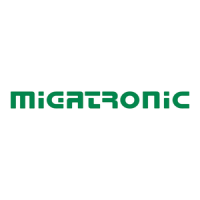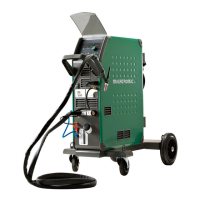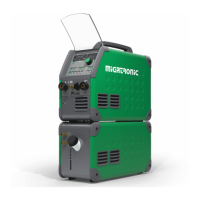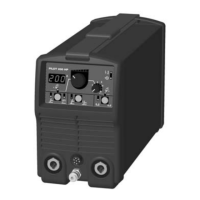18
Connection of remote control
PI 400 PLASMA can be controlled via a remote control
or a welding robot. The remote control socket (14) has
terminals for the following functions:
A: Input signal for welding current, 0 –
+10V input impedance: 1Mohm
B: Signal ground
C: Arc detect – contact of relay (max.
1Amp), fully insulated
D: N.C.
E: Arc detect – contact of relay (max. 1Amp), fully
insulated
F: N.C.
G: Supply +24VDC. Short circuit protected with PTC
resistor (max. 50mA).
H: Supply ground
CWF Multi (option)
It is possible to connect to the PI 400 PLASMA with up
to 8 CWF Multi units via dedicated CAN BUS
connector placed on the rear side of machine (option).
In order to permit this control capability, enter the
USER Menu and select "Fdr" (feeder), then access
"Act" (Active devices) and set the parameter to 1. (see
USER MENU)
Now the PI is ready to control the CWF directly from
the box: for each TIG welding program it is possible to
select what CWF unit must be activated and the
relative CWF program in the range 1 to 20.
Depending from the settings on the CWF, if the unit is
in OFF mode the error message “Fdr” can be
displayed on PI and the welding procediment stopped.
This is to inform the user the CWF is not responding to
start signal from PI.
Usage of the machine
When welding, a heating of various components of the
machine takes place and during breaks these compo-
nents will cool down again. It must be ensured that the
flow is not reduced or stopped.
When the machine is set for higher welding currents,
there will be a need for periods during which the
machine can cool down.
The length of these periods depends on the current
setting, and the machine should not be switched off in
the meantime. If the periods for cooling down during
use of the machine are not sufficiently long, the over-
heating protection will automatically stop the welding
process and the yellow LED in the front panel will
come on. The yellow LED switches off when the
machine has cooled down sufficiently and is ready for
welding.
